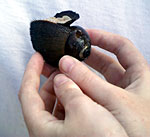|
|
  TODAY'S WEATHER Partly Cloudy 81°F (27.2°C) Latitude: 25 deg 19.21’S Longitude: 70 deg 02.41’E Wind Direction: NNE Wind Speed: 22 Knots Sea State <4 Swell(s) Height: 8-12 Foot Sea Temperature: 79°F (26.1°C) Barometric Pressure: 1007.9 MB Visibility: 10+ Nautical Miles  Black Smoker  Four species of snails, including this hairy snail, were collected at the hydrothermal chimneys last night. 
Daily Update: The Great Snail Escape Collecting snails living at the hydrothermal vents turned into a chase last night when the spiral-shelled mollusks escaped capture- three times. Hairy snails, one of at least four species living at the vents, are a priority for several biologists because the snails are similar to those found at hydrothermal vents in the western Pacific Ocean. The scientists are interested in comparing the genetics of the snails from different oceans to see if the mollusks are related. Last night after collecting a bag full of the plum-sized snails, we were directing Jason back to the elevator when some shrimp distracted us. Rather than lose sight of the shrimp, we decided to leave the bag of snails on the seafloor to pick up later. When we returned, the snails had crawled away. “You don’t think they can go that fast,” said biologist Shana Goffredi, adding that snails move slowly on one muscular foot. “It’s pretty bad when snails are outrunning you.” We then gathered a second bag, which we accidentally dropped from Jason’s manipulator arm. The snails rolled down a hill for another getaway. “By now we thought the snails were truly plotting against us,” said Shana. Determined to capture the snails, we scooped a third load and deposited them into a container on the elevator, then went looking for shrimp. When we returned and lifted the lid, the snails were ready. They had crawled from the scoop and were sticking to the underside of the now-open lid. “Whoosh, they drifted away in the current,” said Shana. In the end, our determination paid off and today 40 snails of four different species joined the shrimp and water samples brought up on the elevator. Both Jason and the elevator will return to the vent site tomorrow morning after a few minor adjustments and repairs. Scientists spent the afternoon dissecting the organisms and analyzing the water samples. Early this afternoon we had a feathered visitor, one of the first since we left Mauritius one week ago. A young red-tailed tropicbird drifted in the winds across the bow, checking us out as we peered back. Though we are about 500 nautical miles and a three-day steam from Rodriguez Island, the nearest landmass, sea birds like this one are adapted to long flights and a fish diet. The tropicbird didn’t linger long before flying to fishier-looking waters. We were glad for its company.
|
||||||||||||||||||||||||||||||||||||||||||||||||||||||||||||||||||||||||||||||||||||||||||||||||||||||||||||||||
Mailing List | Feedback | Glossary | For Teachers | About Us | Contact
© 2010 Dive and Discover™. Dive and Discover™ is a registered trademark of
Woods
Hole Oceanographic Institution